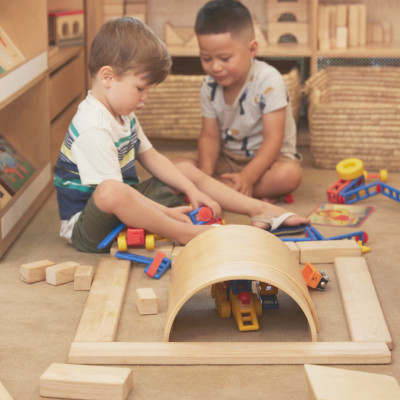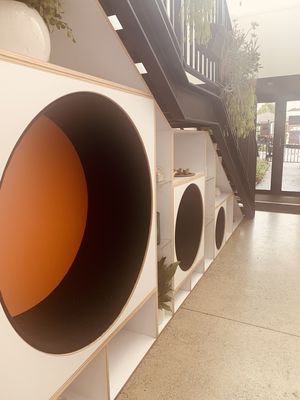By Phil and Tiffany Smith, award-winning early childhood architects, Collingridge and Smith Architects (UK)
Did you know it’s estimated that children spend up to 85% of their time indoors?1 Younger children are also more vulnerable than adults to the effects of indoor environments. This is because of their faster breathing rates, their proportionally larger lungs, their rapid growth, and undeveloped bodies including their immune systems, eyes, and ears.2
How can we improve the quality of our early years' indoor spaces to enhance children’s learning and health? The first step is to consider the three key factors that influence indoor environments from an architectural point of view: air quality, light, and sound.
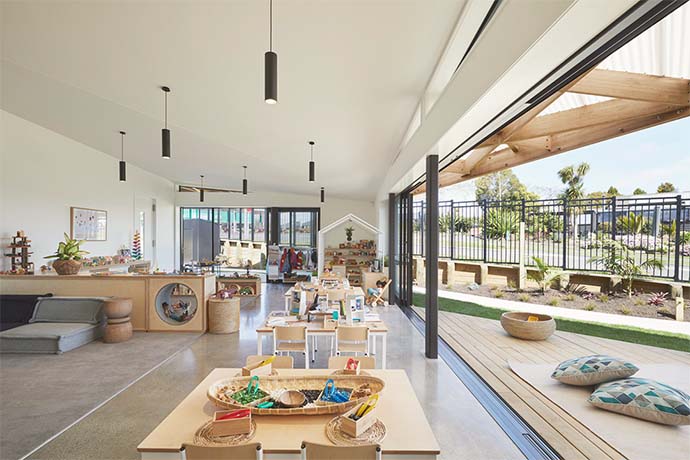
Image of New Shoots Children’s Centre, Kerikeri, New Zealand photographed by Amanda Aitken Photography
Indoor Air Quality
Indoor air quality and thermal comfort affect people’s short-term and long-term health3 with research showing both play significant roles in productivity and learning.4
Inadequate indoor air quality and thermal control increase the airborne transmission and survival rates of respiratory and gastric bacteria and viruses, as well as the growth of mould.5
Paying attention to the quality of the air in your early years' environment is critically important for the health and safety of the children in your care.
Why is clean, fresh air important for children’s wellbeing?
Studies around the world have analysed building-related illness and sick building syndrome, where the occupant’s exposure to an indoor air quality caused a variety of non-specific neurological and respiratory symptoms.6
Historically the most common indoor air pollutant relating to cancer and the primary cause of lung disease was cigarette smoke,7 though more recent research has seen a link between indoor air pollutants and non-respiratory cancers, particularly in children.
Other causes of lung disease that are being researched include environmental factors e.g., exposure to low temperatures and dust.8 This included a study in New Zealand that found an increase of heart diseases with an increase in dust in the air.9
Other research observed a link between increased rates of childhood leukaemia and formaldehyde exposure. Formaldehyde is often found in glues and materials used in furniture, cabinetry and floor covering products10 and also releases volatile organic compounds (VOC’s) into the air. Volatile organic compounds can also be released from paints, vinyl floor coverings, and new furniture
Exposure to mould, dust, and dampness is associated with airway inflammation, nasal congestion, coughing, wheezing, throat irritation, hay fever and eczema.11 It is also likely that increased exposure to dust increases susceptibility to the development of allergies and asthma panorama.12 The correlation is strong between allergic sensitisation and allergen exposure, particularly in school children and children under five years old.13
Try turning the temperature down as children are more sensitive to higher temperatures than adults. Young people are better suited to temperatures a few degrees cooler14 due to their higher metabolic rates and overall level of activity.15 A comfortable range is between 18-21 degrees.
Three easy ways to improve your indoor air quality
- Open windows and doors. First thing in the morning and in the evening, throw open all the doors and windows for five to ten minutes to refresh the inside air – even if you have mechanical ventilation. If you have natural ventilation in your environment, make sure you open the windows and doors during the day – even if it is just a crack on colder and wetter days.
- Keep your room dust-free. Do the shelf and under moveable furniture check! You will be surprised at what you find, especially under that rug. Regularly wiping down window sills, including the rubber window seal, and wiping the extract fans grill the bathrooms, will help prevent the build-up of dust and condensation.
- Use products and resources with no or low volatile organic compounds (VOCs). Furniture and resources, paints and glues often have VOCs that can be harmful to your health. By using no or low VOC products in your environment you’re reducing the risk of exposure.
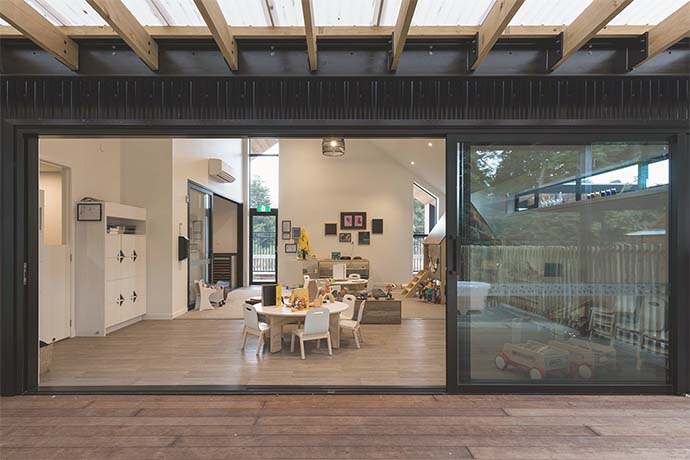
Image of House of Wonders, Cambridge, New Zealand.
Light
Light plays a critical role in regulating numerous physiological and behavioural points including circadian rhythms, sleep regulation, hormone levels and mood, according to research.16
A recent study indicates blue light may enhance attention, cognitive performance and mood,17 though limiting blue light at night or before sleep may help mitigate its negative impact on our circadian rhythm; our internal processes that regulate our sleep-wake cycles over 24 hours.18
Research also tells us the blink reflex in babies does not fully develop until age five19 and that a child’s crystalline lens found at the front of the eye is more transparent to short wavelengths than an adult’s. Therefore children are more sensitive to the retinal effects of blue light.20
It is now evident there are light-sensitive cells at the back of the eye. These cells not only support vision but significantly contribute to the non-visual, eye-mediated effects of light, and influence several biological processes and systems in the human body that are important to health and wellbeing.21 There is also compelling evidence that these cells are essential in early eye development and in how sleep patterns are programmed for later life.22 Other research has shown the importance of natural light in the development of the eyes and the circadian system at this young age.23
Overall we are just starting to understand the effects of light on children.24 That is why it is crucial to learn more about these effects and provide quality indoor natural light and flicker-free artificial light that supplement the natural light on those cloudier days.
Three easy ways to improve your lighting
- Keep any windows clear of posters, notices and artwork. Natural light is not obscured by non-transparent objects. This will help maximise the natural light and reduce the need for artificial light.
- Check lights are working correctly. Change any flickering bulbs or faulty lighting. Where possible swap all fluorescent bulbs with dimmable LED lighting.
- Get at least ten to twenty minutes of natural light on your face a day. Research has shown that natural daylight falling on the back of the eye is a key regulator of our hormones that support our circadian system. It also enables us to produce vitamin D, an essential vitamin that is involved in calcium absorption, immune function, and protecting bone, muscle, and heart health. Though please do be sun wise. To avoid sunburn, the best times of day would be early morning or late afternoon.
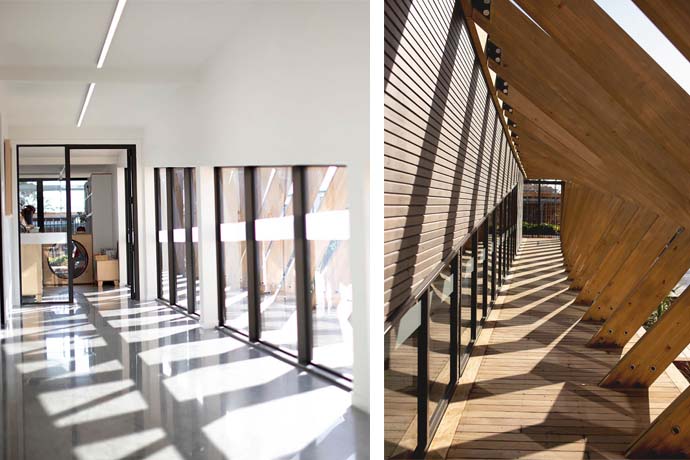
New Shoots Children’s Centre, Whenuapai, New Zealand
Sound
How noisy is it in your early years learning environment? Are there ways you can make it more conducive to the learning needs and health of children in your care?
Research shows short term, noise-induced stimulation may produce better outcomes when simple tasks are being done or in more creative, collaborative workspaces. However, cognitive performance deteriorates substantially for more complex mental tasks, such as activities that require intense attention to detail, demand higher working memory, or are analytically complex.25 The World Health Organisation states:
“Impairment of early childhood development and education caused by noise may have lifelong effects on academic achievement and health”.26
Research indicates that the response in children to reverberation and how loud children feel they need to speak in order to be heard in a space with reverberation (the Lombard Effect) is significantly different from that of adults. Reverberation in a space is potentially damaging to children’s speech intelligibility and responses to background noise27 especially as general noise levels increase. The reason for this is that as general noise levels increase, reverberation in the space increases (the Café Effect). The Café Effect in turn causes speech intelligibility to decrease, which then causes the occupants to feel they need to speak louder to ensure they are heard (the Lombard Effect). This then raises the general noise level and so the cycle begins again, each time getting louder – just like at your local café.
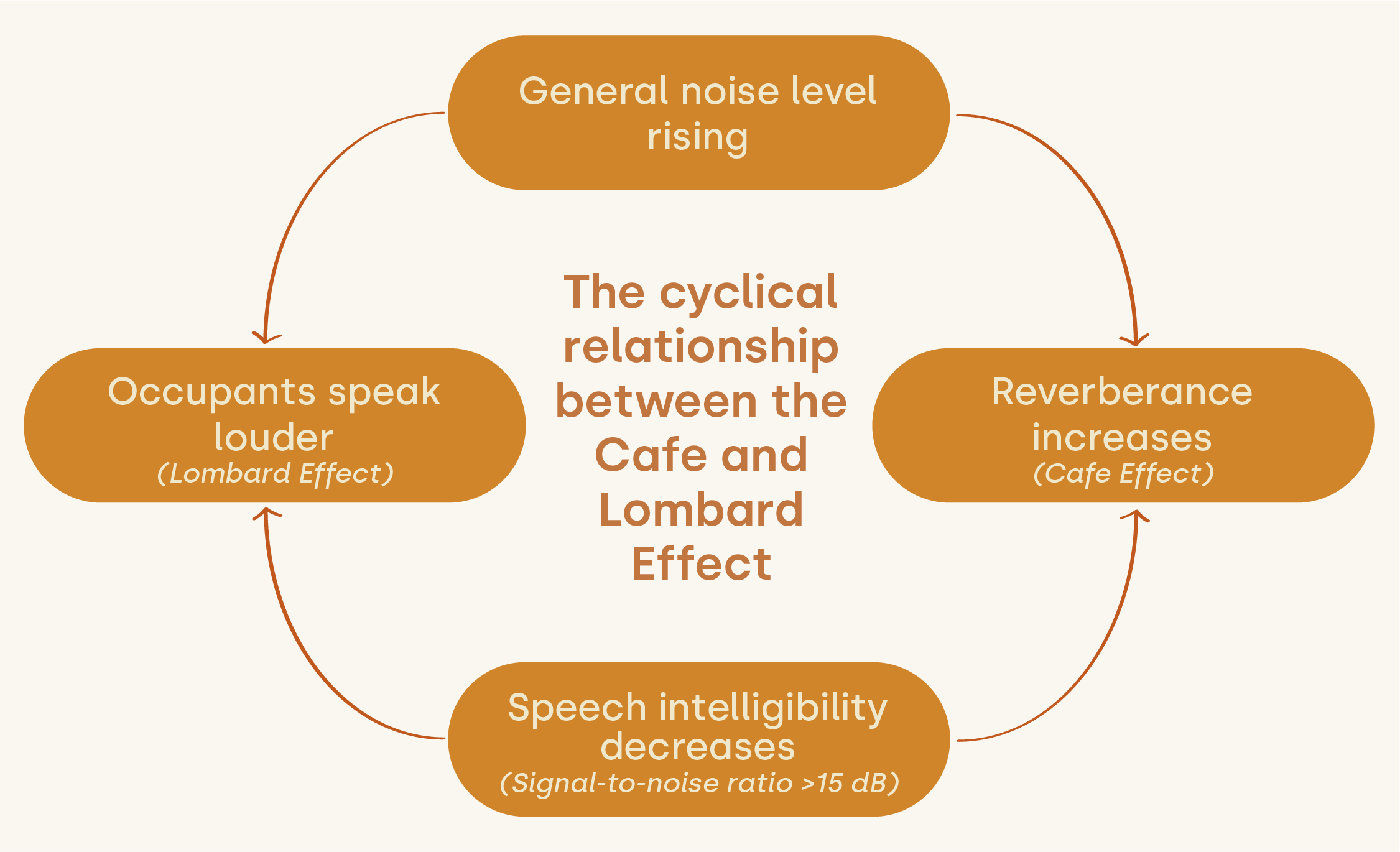
The cyclical relationship between the Café and Lombard effects (Page, 2019)
How does noise impact our health?
There is a direct link between health and noise, including stress-related illnesses, depression, speech interference, high blood pressure, and noise-induced hearing loss (hearing impairment caused by excessive noise exposure).28 Those with a high sensitivity to environmental noise as defined by an 11-point Likert scale, are two times more likely to experience depression than those with low sensitivity to noise. They are also 1.9 times more likely to experience anxiety.29
Noise also affects sleep. Disturbed sleep is associated with several health impacts, including increased heart rate, arousal from sleep, sleep changes, and awakening. Exposure to night noise has been shown to increase body movement and environmental insomnia. Noise-induced sleep disturbance also leads to further health consequences, such as hormone level changes, cardiovascular diseases, depression and other mental health issues.
Children do have a higher awakening threshold than adults; however, they spend more time in bed and, therefore, are exposed to more daytime as well as night-time noise levels.
Three easy sound checks
- Background noise check. Download a sound meter app. When the children are playing outside or asleep use the app to measure the background sound level. Does it exceed 35 dB? Look to see where your background noise is coming from e.g. heat pumps, extractor fans, external traffic.
- Cafe noise check. Use the sound meter app to check the levels mid-way through an indoor activity. Does it exceed 35 dB?
- Hard versus soft surface check. Look around your room to see how much of your room is made of hard surfaces compared with softer surfaces. If more than 50% of your walls and floor surfaces are hard (e.g. painted, timber or concrete) look to break up the hard surfaces with carpet, rugs, plants, and other soft furnishings e.g. sofas, cushions, etc. Retrofitting sound-absorbing panels on the walls and ceilings is also another great way of reducing sound.

Image of Three Trees Learning Centre, Christchurch, New Zealand.
![]()
Phil and Tiffany Smith, owners of Collingridge and Smith Architects (UK) Ltd (CASA) have specialised in designing world-class education architecture for over 20 years, both in NZ and the UK. They believe in creating beautiful human spaces based on research that brings together architecture and evolutionary psychology. They have been recognised for their achievements in sustainable early childhood architecture with their designs achieving many local and international awards for centres including Three Trees Learning Centre, Campbells Bay Early Learning Centre, Fantails Childcare, Chrysalis Early Learning Centre, Kristin Early Learning, Te Mirumiru Childhood Education Centre, and several New Shoots Children’s Centres. Website: www.casa-uk.com
![]()
References
- Lum, S. B., Jenkins, P., & Shimer, D. (2013). Children’s activity patterns and inhalation rates: determinants of exposure and dose. Last access: 23/July/
- Bennett, W. D., Zeman, K. L., & Jarabek, A. M. (2008). Nasal contribution to breathing and fine particle deposition in children versus adults. J Toxicol Environ Health A, 71(3). doi:10.1080/15287390701598200
- Wargocki, P., Sundell, J., Bischof, W., Brundrett, G., Fanger, P. O., Gyntelberg, F., . . . Wouters, P. (2002). Ventilation and health in non‐industrial indoor environments: report from a European Multidisciplinary Scientific Consensus Meeting (EUROVEN). Indoor Air, 12(2), 113-128. doi:10.1034/j.1600-0668.2002.01145.x
- Al Horr, Y., Arif, M., Kaushik, A., Mazroei, A., Elsarrag, E., & Mishra, S. (2017). Occupant productivity and indoor environment quality: A case of GSAS. International Journal of Sustainable Built Environment, 6(2), 476-490. doi:10.1016/j.ijsbe.2017.11.001
- Coates, S. J., Davis, M. D. P., & Andersen, L. K. (2019). Temperature and humidity affect the incidence of hand, foot, and mouth disease: a systematic review of the literature - a report from the International Society of Dermatology Climate Change Committee. Int J Dermatol, 58(4), 388-399. doi:10.1111/ijd.14188
- Anderson, J., Thundiyil, J., & Stolbach, A. (2012). Clearing the air: A review of the effects of particulate matter air pollution on human health. Journal of Medical Toxicology, 8(2), 166.
- Abramson, M. J., Koplin, J., Hoy, R., & Dharmage, S. C. (2015). Population-wide preventive interventions for reducing the burden of chronic respiratory disease. Int J Tuberc Lung Dis, 19(9), 1007-1018. doi:10.5588/ijtld.15.0034
- Abramson, M. J., Koplin, J., Hoy, R., & Dharmage, S. C. (2015). Population-wide preventive interventions for reducing the burden of chronic respiratory disease. Int J Tuberc Lung Dis, 19(9), 1007-1018. doi:10.5588/ijtld.15.0034
- Huang, L., Mo, J., Sundell, J., Fan, Z., & Zhang, Y. (2013). Health risk assessment of inhalation exposure to formaldehyde and benzene in newly remodelled buildings, Beijing. PLoS One, 8(11), e79553. doi:10.1371/journal.pone.0079553
- Gao, C. F., & Lee, W. L. (2011). Evaluating the influence of window types on the natural ventilation performance of residential buildings in Hong Kong. International Journal of Ventilation, 10(3), 227-238. doi:10.1080/14733315.2011.11683951
- Alvarez-Chavez, C. R., Flores-Bernal, J. L., Esquer-Peralta, J., Munguia-Vega, N. E., Corella-Madueno, M. A., Rascon-Careaga, A., . . . Velazquez-Contreras, L. E. (2016). Detection of allergen sources in the homes of sensitized children. Environmental Health And Preventive Medicine, 21(6), 531-538. doi:10.1007/s12199-016-0566-7
- Anderson, J., Thundiyil, J., & Stolbach, A. (2012). Clearing the air: A review of the effects of particulate matter air pollution on human health. Journal of Medical Toxicology, 8(2), 166.
- Edwards, N. M., Myer, G. D., Kalkwarf, H. J., Woo, J. G., Khoury, P. R., Hewett, T. E., & Daniels, S. R. (2015). Outdoor Temperature, Precipitation, and Wind Speed Affect Physical Activity Levels in Children: A Longitudinal Cohort Study. J Phys Act Health, 12(8), 1074-1081. doi:10.1123/jpah.2014-0125
- The New Zealand Ministry of Education. (2017). Designing quality learning spaces: Indoor air quality and thermal comfort.
- Branco, P. T. B. S., Alvim-Ferraz, M. C. M., Martins, F. G., & Sousa, S. I. V. (2015). Children's exposure to indoor air in urban nurseries-part I: CO2 and comfort assessment. Environmental Research, 140, 1-9. doi:10.1016/j.envres.2015.03.007
- Goz et al., 2008; Guler et al., 2008; Hatori et al., 2008; Milner & Do, 2017; Pilorz et al., 2016; Boyce & Barriball, 2010
- Milosavljevic, Cehajic-Kapetanovic, Procyk, & Lucas, 2016
- Eunice Kennedy Shriver National Institute of Child Health and Human Development, 2019)
- Tomita, Y., Shichida, K., Takeshita, K., & Takashima, S. (1989). Maturation of blink reflex in children. Brain and Development, 11(6), 389-393. doi:10.1016/s0387-7604(89)80022-1
- Point, S. (2018). Blue light hazard: are exposure limit values protective enough for newborn infants? Radioprotection, 53(3), 219-224. doi:10.1051/radiopro/2018025
- Hattar, Liao, Takao, Berson, & Yau, 2002; Mrosovsky & Hattar, 2009; Semo et al., 2010; LeGates et al., 2012; Warthen, Wiltgen, & Provencio, 2011; Tam et al., 2016; Milosavljevic et al., 2016; Goz et al., 2008; Guler et al., 2008; Hatori et al., 2008; Milner & Do, 2017; Pilorz et al., 2016
- Tufford, A. R., Onyak, J. R., Sondereker, K. B., Lucas, J. A., Earley, A. M., Mattar, P., . . . Cayouette, M. (2018). Melanopsin retinal ganglion cells regulate cone photoreceptor lamination in the mouse retina. Cell Rep, 23(8), 2416-2428. doi:10.1016/j.celrep.2018.04.086
- Palumaa, T., Gilhooley, M. J., Jagannath, A., Hankins, M. W., Hughes, S., & Peirson, S. N. (2018). Melanopsin photoreceptors physiology and potential. Current Opinion in Physiology, 5, 68-74. doi:10.1016/j.cophys.2018.08.001
- Mattsson, M. O., Jung, T., & Proykova, A. (2012). Scientific committee on emerging and newly identified health risks - Health effects of artificial light.
- World Health Organisation Regional Office for Europe, 2019, p. 2
- Irgens-Hansen et al., 2015
- Newman, 2005; Whitlock & Dodd, 2008
- Baliatsas, van Kamp, van Poll, & Yzermans, 2016; Basner et al., 2014; Beutel et al., 2016; Eze et al., 2018; Liu et al., 2013; Luetz et al., 2016; Moudon, 2009; Szalma & Hancock, 2011; United States Environmental Protection Agency, 2017
- Park et al., 2017
 Tiffany Smith
Tiffany Smith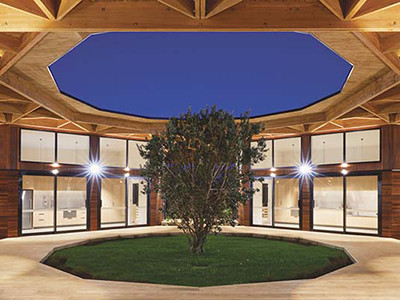

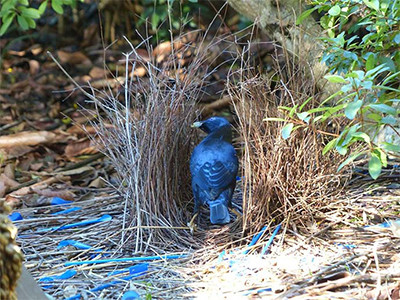

 Michelle Pratt
Michelle Pratt